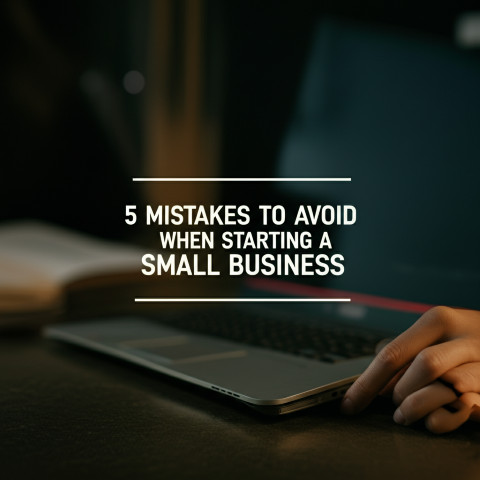
5 Mistakes to Avoid When Starting a Small Business
Starting a small business is exciting, but it's also risky. Many new businesses fail within the first few years, often due to preventable mistakes. Avoiding these common pitfalls can significantly improve your chances of success. Here are five crucial mistakes to avoid:
1. Lack of a Solid Business Plan
A business plan is your roadmap to success. It's more than just a document; it's a living, breathing strategy that guides your decisions. Without a comprehensive plan, you're essentially navigating blindfolded. Your business plan should include:
- Executive Summary: A brief overview of your business.
- Company Description: Details about your business, its mission, and its structure.
- Market Analysis: Research on your target market, competitors, and industry trends.
- Organization and Management: Information on your team, their roles, and your organizational structure.
- Service or Product Line: A description of what you offer and its unique selling points.
- Marketing and Sales Strategy: Your plan for reaching your target customers and making sales.
- Funding Request (if applicable): Details on how much funding you need and how you'll use it.
- Financial Projections: Forecasts of your income, expenses, and profitability.
- Appendix (optional): Supporting documents such as market research data or resumes.
Don't underestimate the importance of a well-researched and detailed business plan. It will help you secure funding, make informed decisions, and stay focused on your goals.
2. Underestimating Startup Costs
Starting a business requires significant upfront investment. Many entrepreneurs underestimate these costs, leading to cash flow problems down the line. Beyond initial expenses like equipment and inventory, consider:
- Legal and professional fees: Incorporating your business, registering trademarks, and hiring consultants.
- Marketing and advertising: Building brand awareness and attracting customers.
- Rent and utilities: Costs associated with your workspace.
- Software and technology: Tools to run your business efficiently.
- Contingency fund: Unexpected expenses always arise. A cushion is essential.
Create a detailed budget that accounts for all potential expenses, and build in a safety net. Running out of cash is a major cause of small business failure.
3. Neglecting Marketing and Sales
Having a great product or service isn't enough. You need a solid marketing and sales strategy to reach your target customers. Many new businesses fail because they don't effectively promote their offerings. Consider:
- Developing a strong brand identity: Creating a logo, website, and consistent messaging.
- Utilizing digital marketing: Social media, search engine optimization (SEO), and online advertising.
- Networking and building relationships: Connecting with potential customers and partners.
- Offering excellent customer service: Building loyalty and positive word-of-mouth referrals.
- Tracking your results: Monitoring your marketing efforts and making adjustments as needed.
Marketing is an ongoing process, not a one-time event. Continuously adapt your strategy based on what's working and what's not.
4. Ignoring Financial Management
Keeping track of your finances is critical for the health of your business. Poor financial management can lead to inaccurate financial statements, missed tax deadlines, and ultimately, business failure. Key aspects include:
- Accurate bookkeeping: Maintaining detailed records of all income and expenses.
- Regular financial reporting: Creating profit and loss statements, balance sheets, and cash flow statements.
- Tax compliance: Understanding and meeting all tax obligations.
- Seeking professional advice: Consulting with an accountant or financial advisor.
- Managing cash flow: Ensuring you have enough cash on hand to meet your obligations.
Don't try to handle your finances alone, especially if you lack experience. Seek professional help to ensure you're making sound financial decisions.
5. Failing to Adapt and Innovate
The business landscape is constantly changing. What works today may not work tomorrow. Failing to adapt to market trends and innovate your offerings can lead to stagnation and decline. Consider:
- Monitoring industry trends: Staying informed about changes in your industry and adapting your strategies accordingly.
- Seeking customer feedback: Regularly soliciting feedback from your customers to improve your products and services.
- Embracing new technologies: Utilizing technology to improve efficiency, reach new customers, and enhance your offerings.
- Being open to change: Adapting your business model as needed to respond to market conditions.
- Continuously learning and improving: Staying updated on best practices and investing in your own professional development.
Flexibility and adaptability are crucial for long-term success. Embrace change, innovate, and continuously improve your business to stay ahead of the competition.
Starting a small business is challenging, but with careful planning and execution, you can significantly increase your chances of success. By avoiding these five common mistakes, you'll be well on your way to building a thriving and sustainable enterprise.

